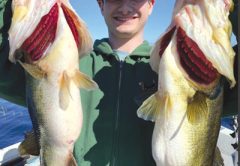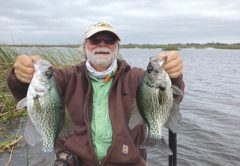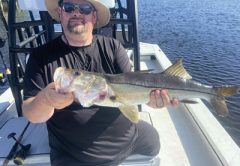The dog days of summer are upon us. As I write this column, the weather channel is forecasting a high of 97 today with light winds. Summertime in Florida.
The perfect recipe for sunburn and a tough day on the water. For most of us, the only solution is to get up at 4:am and try to be on the water as the sun comes up. The weather at 6:am is about as perfect as it can get, typically 72 to 73 degrees, but it won’t stay that way very long. By 9:am the sun is up and the heat begins to get uncomfortable. For many of us, it’s time to head for the boat ramp.
The good news is it won’t last forever. In a few short months, the weather may still be hot, but the nights will cool down, as will the water temperatures and fishing will improve dramatically as the bass begin to feed aggressively in preparation for the spawn towards the end of the year. Fall fishing can be the best time of the year to catch aggressive, heavy bass.
Although fishing can be very good during the summer months, many fishermen limit their time on the water, often spending the time in air conditioned areas updating their tackle and equipment in preparation for the cooler weather.
This can be a great opportunity to take a hard look at your rods and reels. Do you have the right combinations to fish in our lakes and rivers?
One of the questions I hear most often from fishermen is “what are the benefits of using a baitcasting rod and reel over a spinning outfit”? “And what about a spincast rod and reel, is there a benefit to using them as well”?
Let me start with the spincast style. Spincast reels are probably the easiest models to fish with since they offer an enclosed area where the line is stored. They generally sit on the top-side of a rod and with the push of a button; line is released and retrieved with very little chance of a backlash. They are the obvious choice for children and fishermen frustrated with backlashes or anyone looking for a simple method of casting and retrieving lures or live bait. Coupled with a baitcasting rod of 6’ to 7’ in length, most people can master the cast very quickly and comfortably with almost no problems. Models range in price from $9.99 to over $100.00, with the more expensive models performing better and lasting longer. The biggest disadvantage to a spincast reel is their inability to handle heavier weights of monofilament line. Most are designed for light line weights of 6 to 10 weight and will quickly present problems if loaded with heavier weight lines. Braid will work on most, but it too can cause problems for the opposite reason. But all things considered, a spincast outfit is perfect for many fishermen.
The real debate is between spinning and casting models. For years, no self-respecting bass fisherman would be caught with a spinning rod and reel in their arsenal. Baitcasting was the way to go, along with heavy, stiff rods, and it’s still the choice of many die-hard fishermen.
But over the last ten years, many bass fishermen, including most, if not all the pro’s have recognized the benefits of using a spinning rod and reel.
Spinning reels, coupled with a 6’ to 7’ rod offer the ability to use lighter lines, cast lighter lures, “skip” baits up and under docks or other structures, and often cast farther than with conventional baitcasting reels. Once you get the hang of it, they are often less likely to “backlash” and work just as well with monofilament and braided line. They are also most often used for “drop-shotting”, one of the most popular methods of fishing deep water structure that’s become popular over the last several years. Quality spinning reels can be purchased for $50 to $100.
I’ve been using spinning outfits for the past 20 years, specifically for fishing plastic worms, small jigs and flukes. Since I’m right-handed, I cast with my right arm and I keep the rod in my right hand and reel with my left hand. Unlike a baitcaster where you cast with your right arm, switch the rod over to your left hand and reel with your right hand. Particularly fishing with plastic worms and jigs, the bite is often very subtle and I believe I can feel the “bite” better in my dominate arm. My right arm is also stronger than my left, so setting the hook is another important aspect. My ability to detect and set up is considerably better using a spinning reel.
I also use a spinning outfit when I want to down-size my lures. Nowadays, everyone talks about 50 and 65 lb braid for fishing in Florida, but often, having the ability to go to lower line weights to throw smaller baits will fill up a livewell much faster. Casting small baits with a baitcaster is possible, but only with lighter lines.
Where spinning equipment falls short, in my opinion, is flipping and pitching. Both require much heavier line and much heavier rods, as well as much longer rods. In Florida where a lunker bass could be your very next bite, a good baitcasting reel filled with 50-65 lb braided line is your best bet.
I’ve watched as many people have tried to pitch and flip with a spinning reel. I’ve attempted it as well, but the problem is the extended reel handle on the spinning reel. It will invariably “catch” your line as you feed it out. It can be done, but it’s often painfully difficult compared to using a baitcasting reel.
Baitcasters also work best with spinnerbaits, topwater baits and crankbaits. Coupled with the right rod for the chosen lure, accuracy is virtually guaranteed with a baitcasting reel.
Obviously, the downside to baitcasters is the inevitable “backlash”, or as the pros call it, the professional over-run. For many fishermen, this is the reason they are not comfortable with using a baitcasting reel. Many tried it in the past, but baitcasting reels have improved dramatically over the years and with new technology, can often be set up correctly to totally eliminate any chance of a backlash. Quality baitcasting reels can be purchased for $75 to $200.
Regardless of your choice, all three reels will provide you with plenty of opportunities to catch fish.
[easy-social-share]






